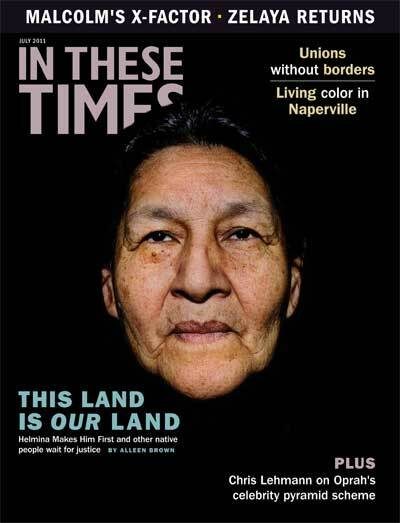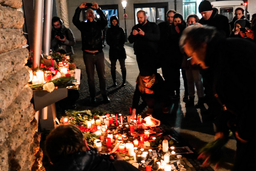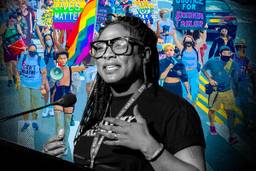Living Color in Naperville
What did living in a white conservative suburb teach a progressive African woman about race in America?
Stephanie Shonekan

Friends vigorously advised me against buying a house in Naperville, Ill. They could not understand why I, an enlightened, progressive African woman, would consider taking my family to live in a white conservative Republican suburb. After all, the Hyde Park and Bronzeville neighborhoods of Chicago, or the liberal, integrated suburbs of Evanston and Oak Park were places where we would “fit in.”
As a black studies scholar who has lived in the United States for 15 years, I am not naive about race in America. My husband and I joke that if we had been scared of white folks, we would not have moved to the United States. But our more serious response was that excellent public schools should not be out of our reach because we are black.
Six years later, we have never regretted our move. We found great neighbors and formed lifelong friendships with people whom I would never have known in my other walks of life. And the greatest lesson learned has come from the reflections on race inspired by the very acute experience of being a black person in a privileged white neighborhood.
The life of a minority is full of oppressive potholes that “majority folks” never have to think of. We constantly pull out our race lenses to study each daily encounter in this white world, to see if there is more than meets the naked eye, to see if our perceptions of race and racism are legitimate. Living in a predominantly white neighborhood, this impulse is magnified. I’ve had lots of conversations with white friends who talk about “post-racial America” and the incredible fact that the U.S. president is a black man. My response: You cannot assume to know whether racism exists if you are not a racial minority yourself.
I’ve found an analogy to explain my position: I enjoy watching soccer. When grown men fall to the ground and roll around because they’ve been kicked in the groin, I feel like telling them to suck it up and keep playing. Yet all the men in my life have sworn that such an occurrence is horribly painful. I will never know what being kicked in the groin feels like because I’m not a man. I just accept and respect their perspective because they know how it feels. In the same way, a white person will never really know what the perceptions of race are from my end of the color spectrum.
Book club ladies
On the one occasion when I could not attend my monthly book club meeting, my white friends argued about the selection of a new book for the next month. Someone proposed The Help, a novel about black maids in the South who worked for white women during the Civil Rights Movement. My closest friend in the book club objected to this suggestion because I, the only black member of the club, might feel uncomfortable reading and discussing this book. The other ladies insisted that I would be fine with it because this book was not about blacks like me. They reasoned that I am African, not African- American, so I should have the necessary distance to simply enjoy the book as good fiction.
On the one hand, I was happy to know that their five-year association with me had sensitized these women to the fact that black folks are not a homogeneous clump of humanity. It’s good that they have reached a stage where they can afford me the privilege of a nuanced black identity. But there is an irony here. In rushing to appear racially astute, they lost sight of the obvious: I may be “African,” but in this country I am still “black.” This is America, where skin color is still the immediate signifier of race, a fact that prevents a collective intellectual shift toward a more thoughtful consideration of ethnicity and sub-cultural significance.
I had to learn this when I first moved to the United States. Growing up in Nigeria, even though it was a colony of Britain where white power was a given, there were enough of us that we were not preoccupied with the complexities of blackness. Instead, we thought more about the particularities of our own varied ethnicities. In the United States, we “Continential Africans” have learned that being black requires a very different understanding of how that identity relates with whiteness. So, I would respond to a book club discussion of The Help that focused on hierarchical white-black relationships from both my position as a black in the United States and as an African.
My book club friends meant well, but race in America is much more complex for the minority than it is for the dominant group. Over the last five years, I have been unable to convey to them the essence of what it means to be black.
Growing up with nappy hair
As for my children, they’ve thrived in school and have wonderful friends. I cringed when I saw their white friends constantly touch their hair in a mixture of wonder and confusion. But I chuckled when my 8-year-old son announced that like his best friend, he would be growing out his hair to donate to kids with cancer. I explained that he would have to think of a different way to contribute because even if he escaped future haircuts, he would never achieve what his blond buddy would be able to accomplish.
Other episodes are not so harmless. My 11-year-old daughter and her best friend (who is biracial) worked very hard to prepare for the auditions for the school play–Beauty & the Beast. After the cast list was published and they (and the few other black hopefuls) were given the anonymous roles of dusters and brooms, I overheard them lamenting that they were not given a speaking role because they were black. As I mulled over an appropriate response, I realized that even if all the white kids were indeed better than all the black kids who auditioned, that would not prevent this perception from taking root. I heard the same reaction from other black parents who have lived in Naperville for years. They said that most of the few black kids in the school have stopped auditioning. In spite of the perception of racism, my daughter and her friend decided that they would be the best dusters ever – and their smiles were wider than Belle’s when she found out that the beast was a prince.
For my children, as it is for me, the concept of blackness is profound and complex. Like other black kids who are perceived as atypical, my kids are often shunned by their African American classmates who navigate the world as a tight group and are dismissive of black kids who don’t quite fit the profile, i.e. their hair is too natural, their friends are too white and their English too proper. So my kids have to find their own path somewhere in the middle – certainly not white, yet not completely “black.” My husband and I have always resisted handing our children those race lenses I mentioned earlier, but each of them, individually, seems to be finding the way to his or her own lenses.
As we pack up our house for a move to Columbia, Mo., a liberal university town in the buckle of the Bible Belt, I am glad we did not hearken to the voices of reason and stay away from Naperville. Here we are so clearly “the other” that it forced us to be proud of who we are – Continental Africans and black folks. Naperville also taught us how white hegemony works in “post-racial” America, where perceptions of discrimination and realities of racism remain woven into the fabric of our daily existence.

I hope you found this article important. Before you leave, I want to ask you to consider supporting our work with a donation. In These Times needs readers like you to help sustain our mission. We don’t depend on—or want—corporate advertising or deep-pocketed billionaires to fund our journalism. We’re supported by you, the reader, so we can focus on covering the issues that matter most to the progressive movement without fear or compromise.
Our work isn’t hidden behind a paywall because of people like you who support our journalism. We want to keep it that way. If you value the work we do and the movements we cover, please consider donating to In These Times.





